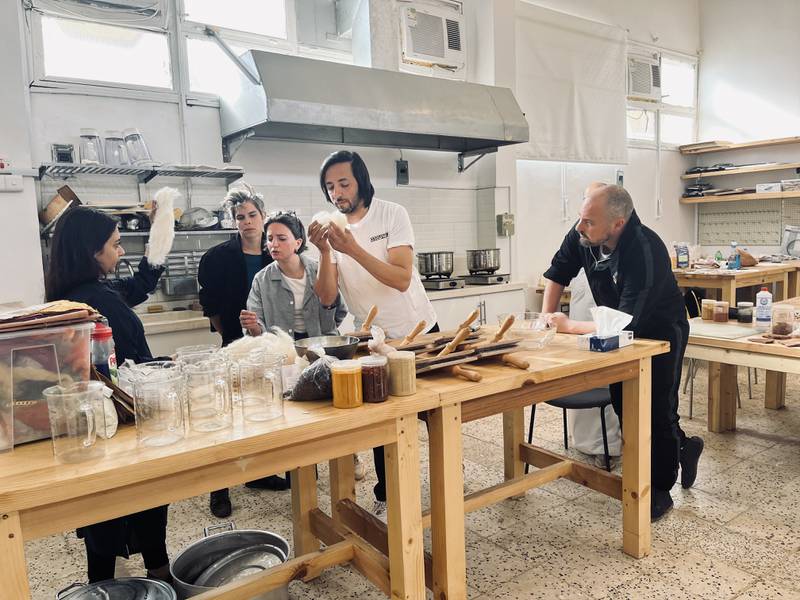AlUla Oasis: six artists to visually transform the cultural site in Saudi Arabia

Six artists have been living in AlUla Oasis in north-western Saudi Arabia since the start of November as part of the pilot version of AlUla's first artists' residency programme. They have been collaborating with specialists who are developing the natural oasis into the planned 50-square-kilometre hospitality, heritage and cultural venture.
The goal of the scheme, says Arnaud Morand of Afalula, the French organisation assisting in the development of AlUla, is to create “co-operation between international artists and the impressive array of scientific experts currently working in the oasis, from archaeologists, anthropologists, agriculture experts and botanists."
Alfalula organised the programme alongside the Royal Commission for AlUla (RCU), the Saudi governmental department overseeing the development project, and the French cultural agency Manifesto.
Sofiane Si Merabet, an artist taking part in the programme, says: “I’d like to think I’ve helped the experts, like the archaeologists, change the perception of their own jobs.
“What’s so interesting is that we’re not just tackling one period of AlUla. AlUla is very famous for the Nabatean tombs, but they are discovering new civilisations, like the Dadan, and at the same time you have the people who were living in the gardens in the oasis, and they moved to the modern town."
Si Merabet, who is French-Algerian and lives in Dubai, works as an artist and also operates the popular social platform the Confused Arab, which investigates the multiplicity of identities worn by Arabs. He has been speaking to the local residents of AlUla, compiling information on their ceremonies and daily practices and the way they interacted with the area's famed Nabatean tombs before they became an international tourist attraction.
“AlUla was an urban centre – you had one of the Ottoman train stations, and one of first schools of the kingdom was in AlUla,” he says. “So you have a duality in the identity of AlUla. The locals did not discover again the place – for them, it was already there. They used to visit the tombs with their families.”
The artists have been living in Mabiti hotel and working in the Madrasat AdDeera, a former girls’ school that is in the process of being transformed into a major art and design centre. The programme has been deliberately multidisciplinary, with workshops ranging from traditional wool-dyeing techniques, organised by the Princes’ Foundation School of Traditional Arts, to agricultural husbandry.
The cohort is likewise relatively diverse. The artists involved are Rashed AlShashai and Muhannad Shono from Saudi Arabia; French artists Sara Favriau and Laura Sellies; and two artists who live in the UAE – Syrian artist Talin Hazbar and Si Merabet.
Hazbar trained as an architect and often uses natural materials. For her work as part of this residency, she is responding to the excavations and natural crevices of the surroundings, which is still taking shape. Shono, by contrast, is known for his arresting, visually spectacular installations, such as the evocatively disturbing thick filaments of black PVC pipe that wended through Desert X AlUla in 2019.
The theme of this year’s programme is the rebirth of the oasis, and Morand says the natural environment of AlUla will remain an important part of future residencies.
We have experts who have been researching the oasis and botany of AlUla for several years now,” says Morand. “The specificity of what is on site is absolutely amazing, and we are starting to dive into how the plants, water and ecology can create research and production for further cohorts."
AlUla's artists' residency programme is likely to grow in the future, and will be determined by an international selection panel. For this pilot scheme, the three stakeholders are planning an exhibition of the artists’ work for later in the spring.
The extent to which the artists will be able to influence the development of the site itself is unclear. But the programme is an important symbol for how Afalula and the RCU want cultural practitioners to have a space in the final version of the site, which will comprise five districts, five heritage sites and 15 cultural assets. Nora AlDabal, RCU’s arts and creative planning director, says the RCU envisions “a flourishing cultural ecosystem” and a “campus for arts, engagement, inspiration and creation”.
The site has already been visually transformed by the artists, who have been holding weekly public talks and workshops for the local community and experts. Si Merabat will hold a talk on Thursday on his plans for the installation he will make.Si
"They want culture to be a living part of it,” he says. "Before many people would leave for Riyadh and Jeddah. Now, thanks to these opportunities made possible by history and culture, they can stay where they are.”
